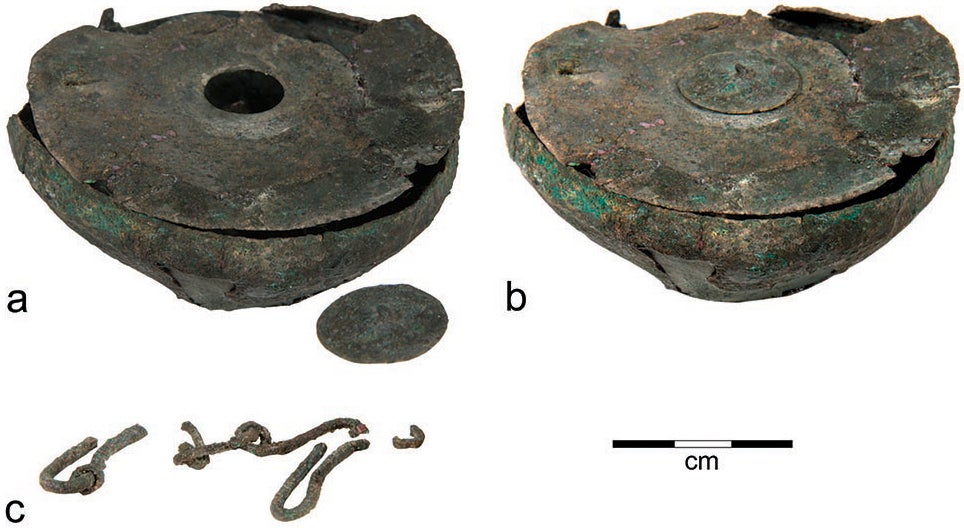In 2008, while excavating an ancient building in the archaeological site of Tel Kedesh, near the modern-day border of Israel and Lebanon, a team of archaeologists found a mysterious collection of personal objects that had been buried under a paving stone sometime in the second half of the second century BCE: a terra cotta figurine of Eros (better known in the Anglophone world by his Roman name, Cupid), twenty-three glass game pieces, two metal writing implements, and a fancy bone hairpin.
The objects captured the archaeologists’ attention—and imagination—because they are all quite personal in nature and show signs of relatively high-quality craftsmanship. Aside from the metal writing tools, which had suffered some damage, all were also found in surprisingly good condition, suggesting that they had been buried together both intentionally and carefully. But why? In a 2017 paper, archaeologist Adi Erlich delves into the cultural significance of the objects in hopes of finding some plausible explanation.

Erlich was especially intrigued by the presence of the glass gaming pieces, which consisted of eighteen pessoi (small round tokens similar to those used to play mancala) and five astragals (or “knucklebones”). It’s not uncommon for archaeologists to find one or two such pieces scattered throughout archaeological sites—after all, they are small and would have been easily lost.
Finding so many all together is quite unusual, however. In fact, one of the only contexts in which an archaeologist would expect to find this quantity—enough to play a number of well-attested ancient games—would be the graves of children and adolescents, where bereaved Greek parents would deposit game pieces and other playthings as funerary offerings.
Stumped, Erlich turned to literary sources for help. She found a tantalizing—if circumstantial—lead in a dedicatory epigram preserved in the Greek Anthology, an omnibus collection of ancient verse put together by various editors in the Middle Ages. The epigram describes a young woman named Hippe, who, having “bidden farewell to her knucklebones,” gives her prized girlhood hair ornament to the goddess Artemis as an offering, “for the solemn time when she must wed has come.”
We have no hard evidence about the author of this epigram beyond his name, Antipater, which was relatively common—he could have lived essentially anywhere and at any time in the ancient Greek world. Intriguingly, however, classicists do know of one poet by that name who lived in the late second century BCE in the city of Sidon—quite close in both space and time to the Tel Kedesh hoard.
If Antipater’s epigram does indeed describe a pre-wedding rite of passage that was practiced in the Hellenistic Levant, is it possible that the unknown individual who buried her game pieces and other personal objects at Tel Kedesh had the same motivations as Antipater’s maiden Hippe?
Weekly Newsletter
We’ll likely never know for sure. Barring the improbable discovery of unambiguous new physical or textual evidence, Erlich’s interpretation must remain a theory, a story that could plausibly explain how these personal objects ended up under a paving stone.
As archaeological theories go, though, it’s an unusually touching and relatable one: the hoard just might, Erlich concludes, tell “the story of an individual young woman who lived and loved and, perhaps, hoped to live ‘happily ever after.’”







